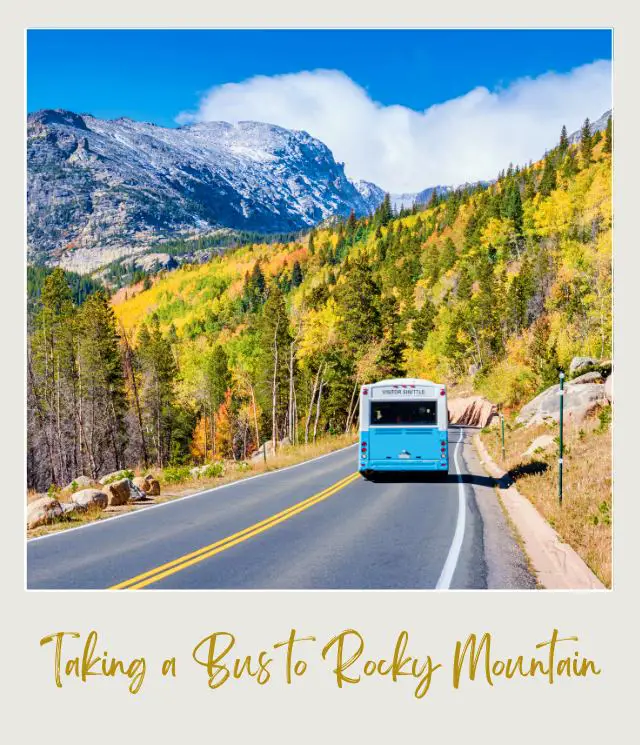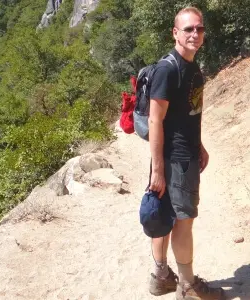If this is your first time visiting Rocky Mountain National Park, then you may be finding planning your trip there a little overwhelming. It’s not uncommon for first-time visitors to Rocky Mountain National Park to feel that way.
Which is why I’ve created this Rocky Mountain National Park visitors guide.
I’m James Ian and I’m a national park expert. I’m happy to share these travel tips for Rocky Mountain National Park with you.
No time right now to read these tips for visiting Rocky Mountain National Park? Pin It and save it for later:
1. Reserve a Timed Entry Permit in Advance
If you’re planning to visit Rocky Mountain National Park in the busy summer and fall months, you’ll need a timed entry permit to access the park during peak hours. This system was implemented to manage visitor capacity and protect the park’s delicate ecosystems.
There are two types of permits – one for the whole park that includes the popular Bear Lake corridor and one for the rest of the park except this area.
Permits can be reserved online through recreation.gov, and you’ll need to book well in advance as they can sell out quickly. I recommend booking the second they become available!
You’ll have to select a specific two-hour entry window, but once inside the park, you can stay as long as you like.
If you have a campground reservation or a service reservation (like a horseback ride or guided hike), you won’t need a separate timed entry permit.
➡️ Read my full guide to the Rocky Mountain National Park timed entry system for more details
2. Arrive Early for Popular Trailheads
Even with the timed entry system, parking at popular trailheads like Bear Lake and Glacier Gorge can fill up quickly, especially on summer weekends. To ensure you get a spot, plan to arrive early in the morning, ideally before 7:00 AM.
Arriving early has other benefits too. You’ll avoid the worst of the afternoon crowds on the trails, and you’ll have a better chance of spotting wildlife like elk and moose, which tend to be more active in the early morning hours. Plus, there’s nothing quite like watching the sunrise over the Rockies from a scenic overlook or trailhead.
➡️ READ MORE: Best Hikes in Rocky Mountain National Park
3. Use the Free Park Shuttle
To ease traffic congestion and protect the environment, Rocky Mountain National Park operates a free shuttle bus system along the busy Bear Lake Road corridor. The shuttle runs from late May through mid October and is a convenient way to access popular trailheads and viewpoints without the hassle of finding parking.
You can park your car at the Park & Ride lot near the Bierstadt Lake Trailhead and take the shuttle to destinations like Bear Lake, Glacier Gorge, and Sprague Lake. Shuttles run every 10-15 minutes from early morning until evening, so you can easily hop on and off throughout the day.
4. Check Road Conditions and Closures
One of the most scenic drives in Rocky Mountain National Park is the Trail Ridge Road, which crosses the Continental Divide at an elevation of over 12,000 feet. However, due to its high altitude, the road is closed in winter and can be impassable well into spring.
Typically, Trail Ridge Road opens in late May and closes in mid-October, but the exact dates depend on weather conditions. Before setting out, check the park’s website or social media for current road status updates.
Even when the road is open, be prepared for chilly temperatures and the possibility of temporary closures due to snow or ice.
5. Stay Hydrated to Combat Altitude Sickness
Many of Rocky Mountain National Park’s most popular destinations are located at high elevations, which can put visitors at risk for altitude sickness. In fact, altitude sickness affects one in five people visiting the park, and everyone is susceptible when traveling above 8,000 feet.
To help prevent altitude sickness, stay well-hydrated by drinking plenty of water throughout your visit. The general recommendation is to drink at least one liter (quart) of water for every 1,000 feet of elevation gain. So, if you’re hiking from the base of the park (around 7,522 feet in Estes Park) to the summit of a 12,000-foot peak, aim to drink at least 4.5 liters of water over the course of the day.
If you can, it also helps to acclimate to the altitude, so try to schedule any higher altitude hikes for later in your trip.
6. Pack Layers for Changing Weather
The weather in Rocky Mountain National Park can be unpredictable, with temperatures varying greatly depending on elevation and time of day. Even in summer, it’s not uncommon for highs to be in the 70s (Fahrenheit) at lower elevations while barely reaching 50°F at higher altitudes.
To stay comfortable in these varying conditions, pack layers that you can easily add or remove as needed. A lightweight base layer, insulating mid-layer, and waterproof outer layer will prepare you for everything from chilly mornings to afternoon rainstorms. Don’t forget to bring a hat, gloves, and extra socks, too – you’ll be glad you have them if you encounter snow or cold winds at higher elevations.
➡️ READ MORE: 20 Best Things To Do In Rocky Mountain National Park In Winter
7. Fill Up Your Gas Tank Before Entering
There are no gas stations within the boundaries of Rocky Mountain National Park, so it’s best to fill up your tank before entering. The park is large, with around 50 miles of road separating the gateway communities of Estes Park (to the east) and Grand Lake (to the west).
This isn’t that long, but if you’re planning on doing a lot of driving within the park, you’ll want to make sure you have enough fuel to avoid running out in a remote area.
There are gas stations in Estes Park (on the east side of the park) and Grand Lake (on the west side of the park), so top off your tank before starting your park adventure.
8. Bring Traction Devices for Winter Hikes
While the park’s lower-elevation trails are often snow-free by late spring, higher-elevation trails can hold snow well into summer. If you’re planning on hiking in Rocky Mountain National Park in winter, spring, or early summer, be prepared for snowy and icy conditions.
Microspikes or crampons can make a big difference in your traction and stability on slippery trails. These devices attach to your hiking boots and have metal spikes or cleats that bite into snow and ice, giving you better footing. They’re especially useful on steep trails like Emerald Lake or Chasm Lake, where a slip could be dangerous.
➡️ If you’re looking for microspikes, check out my guide to the best microspikes for hiking. I have (and love) these Kahtoola Microspikes.
9. Prepare for Afternoon Thunderstorms
In Rocky Mountain National Park, afternoon thunderstorms are a regular occurrence from late June through August. These storms can develop quickly and bring lightning, heavy rain, and even hail to the park’s high country.
To avoid getting caught in a dangerous thunderstorm, plan to start your hikes early in the day and be back below treeline by early afternoon. As a general rule, aim to be off exposed ridges and summits by noon.
If you do hear thunder or see lightning while hiking, immediately descend to lower elevations and seek shelter in a car or building.
10. Use Designated Pullouts for Wildlife Viewing
Rocky Mountain National Park is home to an incredible diversity of wildlife, from elk and moose to bighorn sheep and black bears. While it’s exciting to spot these animals during your visit, it’s important to view them safely and responsibly.
When you see wildlife along the road, use designated pullouts to stop and observe. Avoid stopping in the middle of the road, as this can create traffic jams and unsafe situations for both animals and other drivers.
Use binoculars or a telephoto lens to get a closer look, and always maintain a safe distance. A good rule of thumb is to stay at least 25 yards (75 feet) away from most wildlife and at least 100 yards (300 feet) away from predators like bears and mountain lions.
Enjoy your Rocky Mountain National Park vacation!
More Planning Resources for Rocky Mountain National Park
⭐ Rocky Mountain National Park Guide
⭐ Planning A Trip to Rocky Mountain National Park: 7 Mistakes to Avoid
⭐ Guide to Rocky Mountain National Park Timed Entry
⭐ 20 Best Things To Do In Rocky Mountain National Park In Winter
⭐ Best Hikes in Rocky Mountain National Park
⭐ How to Get to Rocky Mountain National Park
⭐ The Airports Near Rocky Mountain National Park
⭐ Closest Airport to Rocky Mountain National Park
⭐ Best Time to Visit Rocky Mountain National Park
⭐ Visiting Rocky Mountain National Park: What To Expect Throughout the Year
⭐ 10 Fun Facts About Rocky Mountain National Park
⭐ The Best Vacation Rentals in Estes Park
⭐ The Best Estes Park Cabins
Do you have any other Rocky Mountain National Park tips? I’d love to hear about them. Join my private Facebook group National Parks Collectors and comment and let me know (you can also pick up extra planning tips, share your photos and stories with other national park lovers and more).
If you liked these Rocky Mountain National Park travel vacation tips, Pin It to your Rocky Mountain National Park board!
James Ian is a national park, camping and hiking expert.
He has dedicated his life to travel, visiting more than 80 countries, all 7 continents and most of the national parks in the United States. With over 35 years experience in the travel industry, James has worked on cruise ships, at resorts and hotels, and as a travel planner who’s helped hundreds of people plan successful trips to US national parks.
Based on his experience visiting our national parks multiple times, in-depth research and expertise as a travel planner, James has published detailed itineraries for many of the major national parks in the US. These itineraries, as well as in-depth park guides, and other resources will help you have your own incredible trip to US national parks without stress and hassle.
As a national park expert, James has contributed to many publications, including USA Today, Newsweek, Time Business News, Savoteur, Best Trip, and Wired.
Read more…
I’m a member of the Amazon Services LLC Associates Program. As an Amazon Associate I earn from qualifying purchases.













